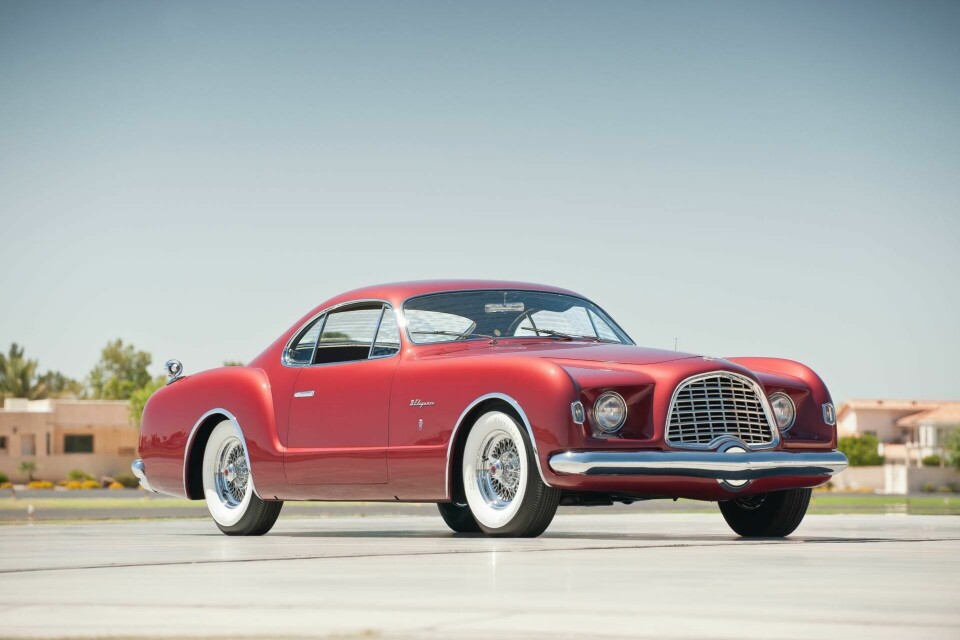
Concept Car of the Week: Chrysler D’Elegance (1952)
The Chrysler concept that would become a Volkswagen
The story of the Chrysler D’Elegance begins, interestingly enough, in the 1940s at Studebaker. That marque’s fabulous two-door Starlight coupé was an instant design classic. But its designers, Virgil Exner and the great Raymond Loewy quarrelled over design credits, and Loewy soon dismissed Exner.

Chrysler, fighting to overcome its long history of frumpy designs, hired Exner to enliven the brand. Exner, with his hand-picked team of young designers, began work on a very successful series of luxury coupés that toured the country as halo cars that pointed to great things ahead for Chrysler, Plymouth, Dodge, and DeSoto. The first of these, the K-310, was a luxury coupé that would form the basis of a whole fleet of design experiments.

During this time, Chrysler, like many of the Detroit car companies, was cultivating a relationship with the Italian carrozzeria that was re-emerging after World War Two. Chrysler and Ghia would work a series of cars together in the 1950s, and their design chiefs, Exner and Luigi Segre, would form a strong professional and personal relationship. The most significant of these co-developed models was an updated K-310 with a more sophisticated, continental-sounding name: D’Elegance.

The sporty coupé was a 5194mm-long and 1372mm-high three-seater with a long hood, a short nose, a fastback and a surprisingly long rear overhang. The D’Elegance featured a number of Exner design flourishes that would become staples of Chrysler styling for the next decade: full wheelarches trimmed in chrome, an embossed spare tyre on the rear deck with a spare mounted on a telescoping hydraulic assembly for easy removal, 17-inch wire wheels, and gunsight tail-lights.

The front of the car was a refinement of the K-310 with similar headlights and grille, albeit with a less apologetic expression and stronger overall appearance. The optimal view of the car seemed to be from the rear three-quarter, which displayed the sculpture of the car to greatest effect.

The interior had been sketched out in purely a schematic way, and although hardly an afterthought, was not as sophisticated as the exterior. Still, it featured a leather seat with a hidden pull-down armrest, leather trim on the dash and an aeroplane-like array of instruments for the driver to monitor. Included with the design was a bespoke set of luggage in matching trim, that fit snugly behind the front seats.

The car was unveiled at the Paris Motor Show in October 1952 and was a great success. However, despite rumours of a limited run of 25 cars for Europe, Exner himself confirmed that this was not the case and the D’Elegance would remain a one-off.

The design, however, would live on through the connection between Ghia and the German coachbuilder Karmann. Volkswagen had a hit on its hands with the Beetle, but, like Chrysler, wanted a sportier car to bring attention to the brand. It turned to Karmann, who was building convertible bodies for VW at the time, and Karmann turned to Ghia, which came up with sketches that were essentially a scaled-down and simplified version of the D’Elegance, whose long rear overhang would be perfect for the rear-engined VW.

The Karmann Ghia made its debut in Paris in 1955 and would go into production soon after. Chrysler design personnel were fearful of Exner’s reaction to the copied design, but when he saw the photographs of the little VW, Exner seemed pleased.

The reason for Exner’s reaction are not recorded, but the most-likely reason was that Exner had already moved on from the long-tailed look of the D’Elegance, with the first of the ‘Forward Look’ Chryslers arriving in the same year as the Karmann Ghia, while the dramatic 1957 models, with their elegantly sculpted bodies and the first of a series of outrageous tail-finned designs, were only 18-months away. The D’Elegance, for all its classic looks, already seemed like the product of another era.

In a way though, the D’Elegance – and, by proxy, the Karmann Ghia – would arguably prove to be Exner’s most successful design. The latter was in production from 1957 to 1974, and almost half a million were built in Europe and Brazil. The design, which could be traced back to the 1940s, would outlast tailfins, and the Forward Look cars, and even the 1960s design languages of Exner’s successors at Chrysler.

It is a long winding road from a glimmer of an idea at Studebaker, to a concept car from Chrysler and Ghia to production at Volkswagen. Yet the one-off coupé’s influential design remains eye-catching to this day, with the D’Elegance fetching $946,000 when it was sold at auction in 2011.




